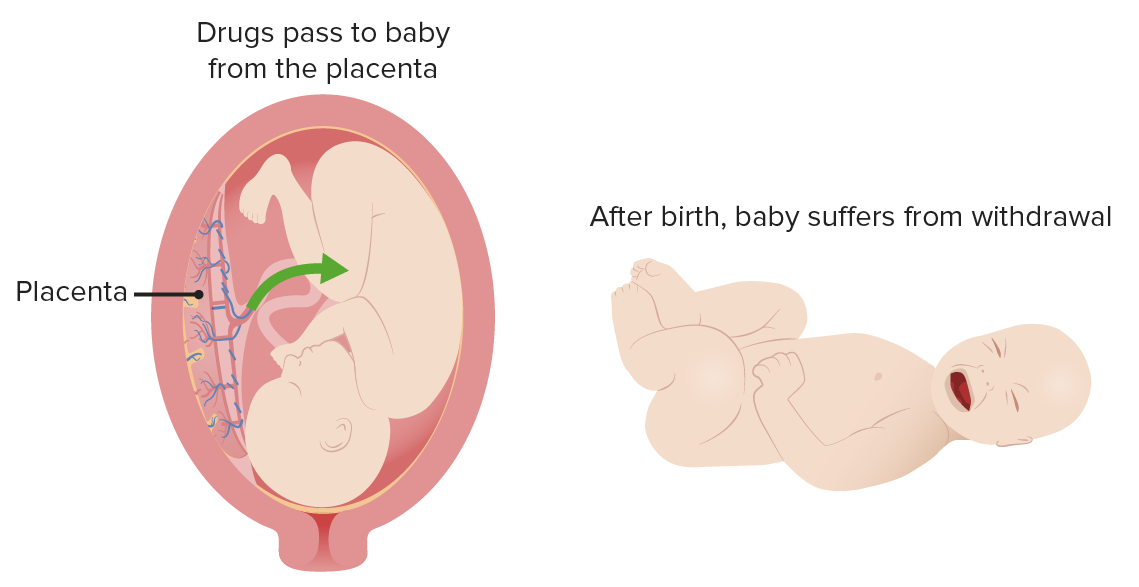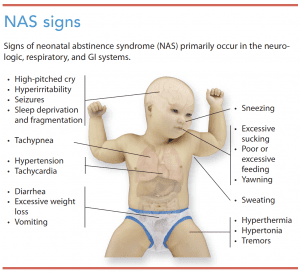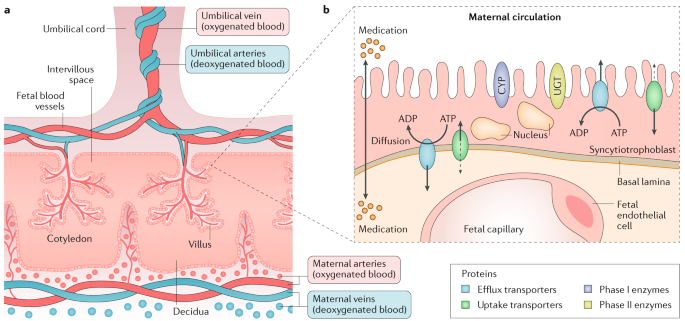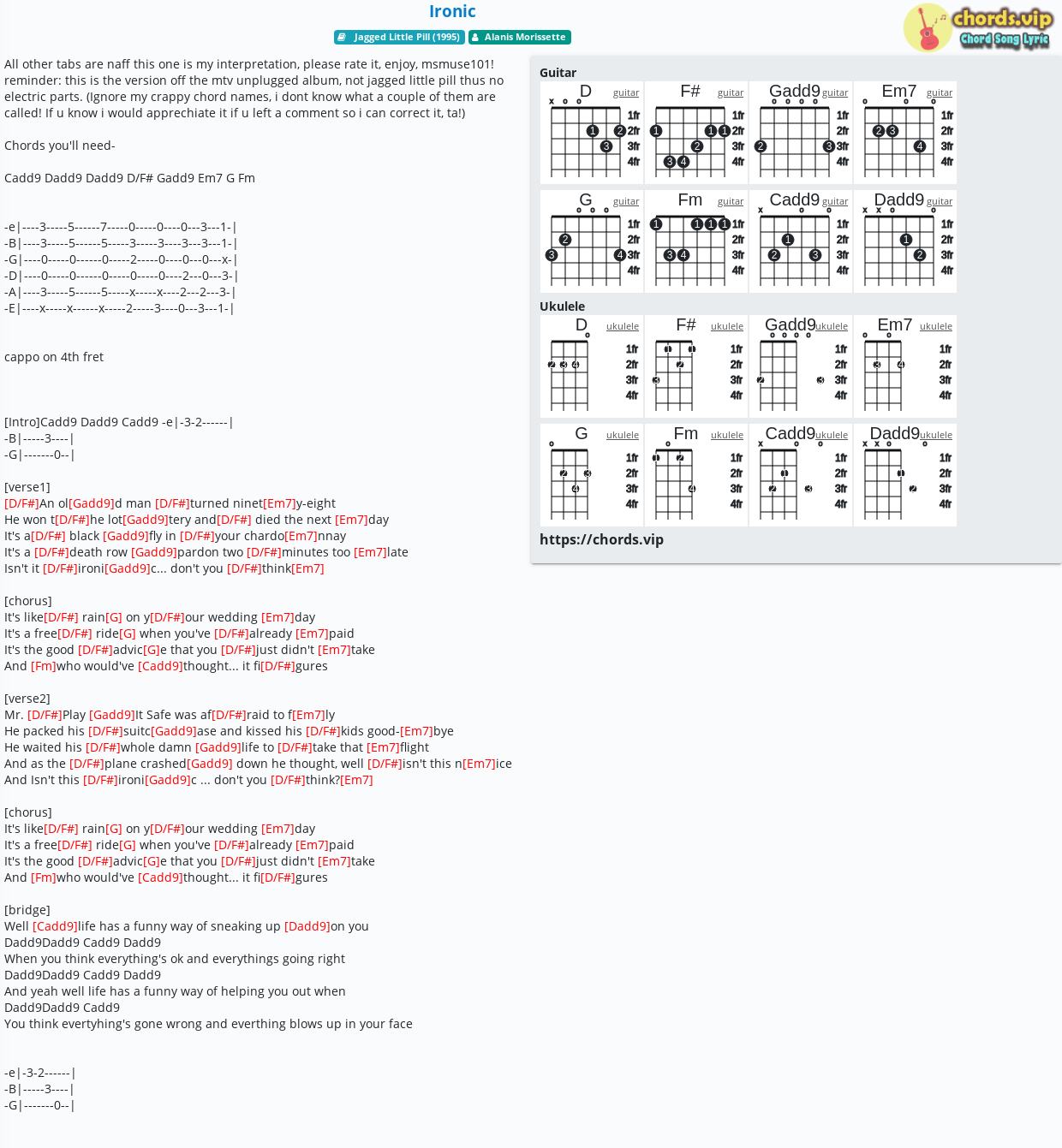Pathophysiology of neonatal abstinence syndrome
Pathophysiology Of Neonatal Abstinence Syndrome. Disruption of the transplacental passage of drugs at birth results in the development of a withdrawal syndrome. Neonatal opioid withdrawal syndrome NOWS is a related term that refers to the symptoms that infants may experience as a result of exposure to opioids specifically. Symptoms of withdrawal may begin as soon as 24 to 48 hours after birth. Walking into a newborns hospital room you can hear him crying.
 Neonatal Abstinence Syndrome American Academy Of Pediatrics From pediatrics.aappublications.org
Neonatal Abstinence Syndrome American Academy Of Pediatrics From pediatrics.aappublications.org
This activity reviews the causes pathophysiology and presentation of perinatal drug abuse and neonatal drug withdrawal and highlights the role of the interprofessional team in managing affected patients and families. This course will help you gain a better understanding of the epidemiology pathophysiology clinical presentation toxicology including drug-drug interactions assessment and treatment of neonatal Neonatal Abstinence Syndrome Care Harvard University. The baby is experiencing newborn drug withdrawal also known as neonatal abstinence syndrome NAS. The predominant symptoms include central nervous system CNS gastrointestinal GI and autonomic manifestations. Or they may start as late as 5 to 10 days after birth. Etiology and Pathophysiology The etiology of Neonatal Abstinence Syndrome NAS is when the mother uses and is addicted to opiate drugs while pregnant.
Although NAS is not a fatal condition it results in significant illness and prolonged hospitalization.
The type of narcotics include heroin codeine oxycodone Oxycontin methadone and buprenorphine. Neonatal abstinence syndrome happens when babies are exposed to drugs in the womb before birth. The predominant symptoms include central nervous system CNS gastrointestinal GI and autonomic manifestations. Disruption of the transplacental passage of drugs at birth results in the development of a withdrawal syndrome. Neonatal abstinence syndrome opioid abuse maternal drug use and substance abuse during pregnancy with a date range of 2009 through 2014. The narcotic goes into the mother and into the fetus through the placenta Lee 2014.
 Source: pediatrics.aappublications.org
Source: pediatrics.aappublications.org
Withdrawal from licit or illicit substances is becoming more common among neonates in both developed and developing countries. Neonatal abstinence syndrome happens when babies are exposed to drugs in the womb before birth. What causes neonatal abstinence syndrome. The type of narcotics include heroin codeine oxycodone Oxycontin methadone and buprenorphine. This activity reviews the causes pathophysiology and presentation of perinatal drug abuse and neonatal drug withdrawal and highlights the role of the interprofessional team in managing affected patients and families.

However rat models show differences between neonatal and adult withdrawal processes. This is characterized as neonatal abstinence syndrome NAS. However since the drug is no longer available your babys central nervous system. The narcotic goes into the mother and into the fetus through the placenta Lee 2014. The study selection process included only material that is scholarly and peer-reviewed.
 Source: pediatrics.aappublications.org
Source: pediatrics.aappublications.org
Walking into a newborns hospital room you can hear him crying. Although NAS is not a fatal condition it results in significant illness and prolonged hospitalization. The study selection process included only material that is scholarly and peer-reviewed. The pathophysiology underlying NAS has not been fully understood. The severity of NAS depends on time type and combination of drugs taken and the feto-maternal metabolic rate.
 Source: nature.com
Source: nature.com
He has tremors and is having difficulty eating and sleeping. Disruption of the transplacental passage of drugs at birth results in the development of a withdrawal syndrome. Neonatal abstinence syndrome opioid abuse maternal drug use and substance abuse during pregnancy with a date range of 2009 through 2014. Although several mechanisms have been. Pathophysiology of neonatal abstinence syndrome.
 Source: paediatricsandchildhealthjournal.co.uk
Source: paediatricsandchildhealthjournal.co.uk
The severity of NAS depends on time type and combination of drugs taken and the feto-maternal metabolic rate. The baby who is three days old is in withdrawal after being exposed to an opioid before he was born. Walking into a newborns hospital room you can hear him crying. Nas is most often caused when a woman takes drugs called opioids during pregnancy. However rat models show differences between neonatal and adult withdrawal processes.
 Source: lecturio.com
Source: lecturio.com
The pathophysiology underlying NAS has not been fully understood. The predominant symptoms include central nervous system CNS gastrointestinal GI and autonomic manifestations. The pathophysiology underlying NAS has not been fully understood. Key points about neonatal abstinence syndrome. It is a multisystemic disorder resulting from chronic in-utero exposure and its abrupt cessation at birth.
 Source: myamericannurse.com
Source: myamericannurse.com
This course will help you gain a better understanding of the epidemiology pathophysiology clinical presentation toxicology including drug-drug interactions assessment and treatment of neonatal Neonatal Abstinence Syndrome Care Harvard University. Neonatal abstinence syndrome opioid abuse maternal drug use and substance abuse during pregnancy with a date range of 2009 through 2014. Neonatal Abstinence Syndrome abstract Neonatal abstinence syndrome NAS is a result of the sudden discon-tinuation of fetal exposure to substances that were used orabused by the mother during pregnancy. Neonatal opioid withdrawal syndrome NOWS is a related term that refers to the symptoms that infants may experience as a result of exposure to opioids specifically. Pathophysiology of neonatal abstinence syndrome.
 Source: ncpoep.org
Source: ncpoep.org
The severity of NAS depends on time type and combination of drugs taken and the feto-maternal metabolic rate. The type of narcotics include heroin codeine oxycodone Oxycontin methadone and buprenorphine. Neonatal abstinence syndrome NAS a constellation of predominantly autonomic neurological and gastrointestinal symptoms is caused by neonatal withdrawal from in utero exposure of maternal misuse of illicit or prescribed drugs. The study selection process included only material that is scholarly and peer-reviewed. The severity of NAS depends on time type and combination of drugs taken and the feto-maternal metabolic rate.

Neonatal abstinence syndrome Neonatal abstinence syndrome NAS is a group of problems that occurs in a newborn who was exposed to opioid drugs. During pregnancy substance abuse is on the rise especially opioids both prescribed and illicit resulting in a hidden epidemic of neonatal abstinence syndrome NAS. Illicit substances that cause drug dependence and addiction in the mother also cause the fetus to become addicted. Although several mechanisms have been. This course will help you gain a better understanding of the epidemiology pathophysiology clinical presentation toxicology including drug-drug interactions assessment and treatment of neonatal Neonatal Abstinence Syndrome Care Harvard University.
 Source: zubsolv.com
Source: zubsolv.com
The baby who is three days old is in withdrawal after being exposed to an opioid before he was born. Etiology and Pathophysiology The etiology of Neonatal Abstinence Syndrome NAS is when the mother uses and is addicted to opiate drugs while pregnant. The pathophysiology underlying NAS has not been fully understood. Pathophysiology Of Neonatal Abstinence Syndrome The pathophysiology of neonatal abstinence syndrome is not completely understood but the clinical presentation suggests that it is primarily caused by excessive noradrenergic activity and by changes in cholinergic dopaminergic and serotonergic transmission111516 In addition two primary. Symptoms of withdrawal may begin as soon as 24 to 48 hours after birth.
 Source: nature.com
Source: nature.com
Neonatal abstinence syndrome opioid abuse maternal drug use and substance abuse during pregnancy with a date range of 2009 through 2014. The study selection process included only material that is scholarly and peer-reviewed. At birth your babys dependence on the substance continues. Neonatal abstinence syndrome NAS is a treatable condition that newborns may experience as a result of prenatal exposure to certain substances most often opioids. Or they may start as late as 5 to 10 days after birth.
 Source: slideshare.net
Source: slideshare.net
Pathophysiology of neonatal abstinence syndrome. Withdrawal from licit or illicit substances is becoming more common among neonates in both developed and developing countries. NAS continues to be an important clinical entity throughout much of the world. Nas is most often caused when a woman takes drugs called opioids during pregnancy. Disruption of the transplacental passage of drugs at birth results in the development of a withdrawal syndrome.
 Source: slideshare.net
Source: slideshare.net
During pregnancy substance abuse is on the rise especially opioids both prescribed and illicit resulting in a hidden epidemic of neonatal abstinence syndrome NAS. Withdrawal from licit or illicit substan-cesisbecomingmorecommonamongneonatesinbothdevelopedand developing countries. NAS continues to be an important clinical entity throughout much of the world. What causes neonatal abstinence syndrome. Neonatal abstinence syndrome NAS is a treatable condition that newborns may experience as a result of prenatal exposure to certain substances most often opioids.
 Source: nature.com
Source: nature.com
It is a multisystemic disorder resulting from chronic in-utero exposure and its abrupt cessation at birth. This is characterized as neonatal abstinence syndrome NAS. Neonatal abstinence syndrome Neonatal abstinence syndrome NAS is a group of problems that occurs in a newborn who was exposed to opioid drugs. The pathophysiology underlying NAS has not been fully understood. Almost every drug passes from the mothers blood stream through the placenta to the fetus.
 Source: sciencedirect.com
Source: sciencedirect.com
The baby is experiencing newborn drug withdrawal also known as neonatal abstinence syndrome NAS. NAS is diagnosed every 25 minutes in the United States. NAS leads to a constellation of signs and symptoms involving multiple systems. The pathophysiology underlying NAS has not been fully understood. Symptoms of withdrawal may begin as soon as 24 to 48 hours after birth.
If you find this site good, please support us by sharing this posts to your preference social media accounts like Facebook, Instagram and so on or you can also save this blog page with the title pathophysiology of neonatal abstinence syndrome by using Ctrl + D for devices a laptop with a Windows operating system or Command + D for laptops with an Apple operating system. If you use a smartphone, you can also use the drawer menu of the browser you are using. Whether it’s a Windows, Mac, iOS or Android operating system, you will still be able to bookmark this website.





